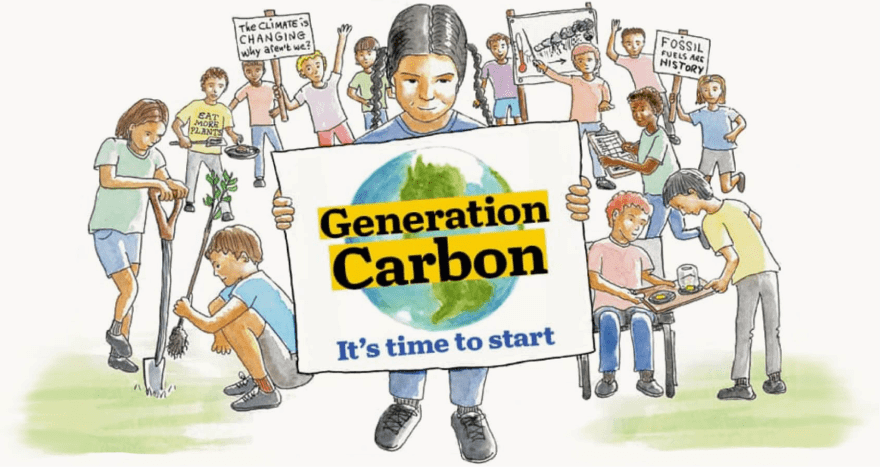What can schools do about the climate crisis?

Environmental Literacy and the elephant in the room
As California faces devastating wildfires, historic droughts, and impending sea-level rise, the impact on our kids and our schools is inescapable. It’s the elephant in the classroom.
The annual carbon footprint of the average Californian is more than the mass of an elephant.
What can parents, educators, student leaders, and community members do about climate change? Fortunately, there’s a clear place to start. California law requires that state-adopted textbooks and instructional materials include information about the environment. California’s Environmental Principles and Concepts (EP&Cs), first approved in 2004 and used as part of a new science framework in 2016, must be included in the state’s guidance for teaching about science, history/social sciences, health, the arts, and mathematics.
This state requirement related to environmental literacy is an ideal entry point to help your local schools take action. In many communities throughout California this work is already underway, so you are likely to find allies quickly. A growing collection of resources can help you find constructive ways to engage in climate action right in your own backyard.
What follows are four strategies for what you can do, including some introductions to people and organizations already helping schools take action.
Strategy #1: Learn how California’s Environmental Principles and Concepts are being used.
These Environmental Principles and Concepts (EP&Cs) are foundational to the work of Ten Strands, a Bay-Area based nonprofit that “acts as a connector, building partnerships and forging pathways to ensure that California’s K–12 students receive a high-quality education with an environmental component.”
Ten Strands works with a wealth of partners, including the California Department of Education and the Lawrence Hall of Science, to help educators and communities strengthen students’ abilities to make informed and creative decisions about environmental issues. A wealth of free curriculum units in Science and History/Social Studies, dealing with everything from food production to energy, are already available from the California Education and the Environment Initiative. In addition, Ten Strands recently announced the Climate Change and Environmental Justice Program (CCEJP) and convened organizations to create more curricular units that will be available as open education resources to all educators in California. Affiliated with Ten Strands, the California Environmental Literacy Initiative provides a wealth of information for families.
Strategy #2: Fill in the gaps in your own knowledge and talk about it.
A quick search of the internet for “climate change” could leave your head spinning. The Carbon Almanac was written for people concerned about climate change but either unsure of the facts or frustrated trying to talk about it. The authors describe it as “the definitive source for facts and the foundation for a global movement to fight climate change.”
Supplemental materials on The Carbon Almanac website are great for taking next steps. The Educator’s Guide helps teachers turn some of the content into lesson plans.
One of the most exciting resources is a kids’ book called Generation Carbon.
The ebook is available as a free downloadable PDF in English and a growing number of translations. The basic premise is that kids can use the book to teach adults the facts. (A print edition is also available.)
For a deeper dive into how the future could look, depending on the steps people take now, go to Probable Futures. Beautifully written and designed, it includes maps that will enable you to look at different scenarios right in your own backyard.
Strategy #3: Learn about how K-12 schools are taking action both in and out of the classroom.
The public K-12 education sector can make a huge impact on climate change directly, as described by the Aspen Institute in its 2021 K12 Climate Action Plan. The goal of this national effort is “to outline the opportunity for America’s K through 12 grade education sector to join the fight against climate change.”
The education of students and adults is front and center in this plan, which calls for efforts “across disciplines and educational settings” including in classrooms, expanded learning programs and in community-based programs such as museums and science centers. “Each educational setting has unique opportunities to engage students by helping them make connections between their own experiences and academic content.” Particular attention needs to be placed on issues of educational equity given that low-income communities are generally more vulnerable to adverse climate impacts.
School buildings and operations create a huge carbon footprint, which the Aspen Institute also addresses with recommendations for potential actions at the local, state, and federal levels. The country’s ~100,000 public schools can mitigate their environmental impact in concrete ways:
- Switch to renewable energy. Just 7% of schools nationally currently use solar power.
- Transition school buses to clean fuels. Currently 94% of the country’s 480,000 school buses burn diesel.
- Reduce food waste and source school meals locally. Schools serve approximately 7 billion meals annually.
Schools also need to plan ahead for how they will support their students and sustain their communities as the climate changes. For example:
- Plan for extreme weather events, which can impact students’ physical and mental health, their academic progress, and their safety.
- Be proactive before an emergency. Create partnerships with nearby districts, provide tiered supports, and train educators and school staff on trauma-informed practices and eco-anxiety.
- Leverage school grounds. Adaptation planning can help reduce community heat and flooding and increase access to green space.
Strategy #4: Ask your local schools’ leaders what they’re doing.
The annual carbon footprint of the average Californian is about 9.1 metric tons — more than the mass of a huge elephant. Most schools are part of the problem, though some are ahead of the curve. Solar panels are a common sight on school grounds in many communities. A growing number of schools are implementing the environmental literacy curriculums described above and the state has provided some funding to support that. The state also has systems in place to support schools during climate emergencies.
Have your public schools gone as far as they can or should? Are they resting on their laurels? Active parent organizations can bring attention to the opportunity local schools have to advance climate solutions, beginning by directing to school district officials questions like these:
|
Sample questions that can lead to climate action in your school community |
|---|
|
Where can parents and students find the comprehensive climate action plans for their school? |
|
How will students, families and community members be engaged in the development of future plans? |
|
What strategies are in place to transition to clean energy and clean transportation? |
|
What is being done to reduce food waste and use local food sources? |
|
How is the district measuring indoor air quality and drinking water safety? What is the plan to mitigate shortcomings? |
|
How is the district assessing local climate risks? What are the plans to prepare, adapt and build resilience to climate change? |
|
How well is teaching and learning about climate change integrated into the curriculum? Is there a plan for strengthening this integration if needed? |
|
How do plans and actions address equity, including the specific needs of families and communities likely to be disproportionately impacted by climate change? |
|
What is the carbon footprint per student at our school? What are the major contributors? |
A report scheduled for release in November 2022 suggests state-level actions for supporting local schools in these kinds of efforts. Information about the report and the advocacy around it is available on the UndauntedK12.org website.
Strength in numbers
Starting a conversation with others in your school community can be the best first step. Together you can identify the opportunities for action and the challenges as well. It can also help you pick your local priorities. Advocacy around climate change issues is also supported by the California State PTA, which means local PTAs have the authority for their associations to jump into this. Three resolutions have been adopted at statewide PTA conventions, including Climate Change is a Children’s Issue, Net Zero Emission Schools, and Plant Based Food Options at School Meals.
Climate change is affecting all of us. It’s not too late to take action.
Tags on this post
All Tags
A-G requirements Absences Accountability Accreditation Achievement gap Administrators After school Algebra API Arts Assessment At-risk students Attendance Beacon links Bilingual education Bonds Brain Brown Act Budgets Bullying Burbank Business Career Carol Dweck Categorical funds Catholic schools Certification CHAMP Change Character Education Chart Charter schools Civics Class size CMOs Collective bargaining College Common core Community schools Contest Continuous Improvement Cost of education Counselors Creativity Crossword CSBA CTA Dashboard Data Dialogue District boundaries Districts Diversity Drawing DREAM Act Dyslexia EACH Early childhood Economic growth EdPrezi EdSource EdTech Education foundations Effort Election English learners Equity ESSA Ethnic studies Ethnic studies Evaluation rubric Expanded Learning Facilities Fake News Federal Federal policy Funding Gifted Graduation rates Grit Health Help Wanted History Home schools Homeless students Homework Hours of opportunity Humanities Independence Day Indignation Infrastructure Initiatives International Jargon Khan Academy Kindergarten LCAP LCFF Leaderboard Leadership Learning Litigation Lobbyists Local control Local funding Local governance Lottery Magnet schools Map Math Media Mental Health Mindfulness Mindset Myth Myths NAEP National comparisons NCLB Nutrition Pandemic Parcel taxes Parent Engagement Parent Leader Guide Parents peanut butter Pedagogy Pensions personalized Philanthropy PISA Planning Policy Politics population Poverty Preschool Prezi Private schools Prize Project-based learning Prop 13 Prop 98 Property taxes PTA Purpose of education puzzle Quality Race Rating Schools Reading Recruiting teachers Reform Religious education Religious schools Research Retaining teachers Rigor School board School choice School Climate School Closures Science Serrano vs Priest Sex Ed Site Map Sleep Social-emotional learning Song Special ed Spending SPSA Standards Strike STRS Student motivation Student voice Success Suicide Summer Superintendent Suspensions Talent Teacher pay Teacher shortage Teachers Technology Technology in education Template Test scores Tests Time in school Time on task Trump Undocumented Unions Universal education Vaccination Values Vaping Video Volunteering Volunteers Vote Vouchers Winners Year in ReviewSharing is caring!
Password Reset
Search all lesson and blog content here.
Login with Email
We will send your Login Link to your email
address. Click on the link and you will be
logged into Ed100. No more passwords to
remember!
















Questions & Comments
To comment or reply, please sign in .
Carol Kocivar December 15, 2022 at 4:36 pm
Schools can now apply for the first round of the Renew America's Schools grant, up to $80 million of the $500 million program, to make energy improvements especially in the highest-need districts across the country. The Energy Champions Leading the Advancement of Sustainable Schools Prize (Energy CLASS Prize) program is also accepting applications for up to 25 local education agencies to receive $100,000 to staff and train select administration and facilities personnel as energy managers.https://www.energy.gov/clean-energy-infrastructure/grants-energy-improvements-public-school-facilities